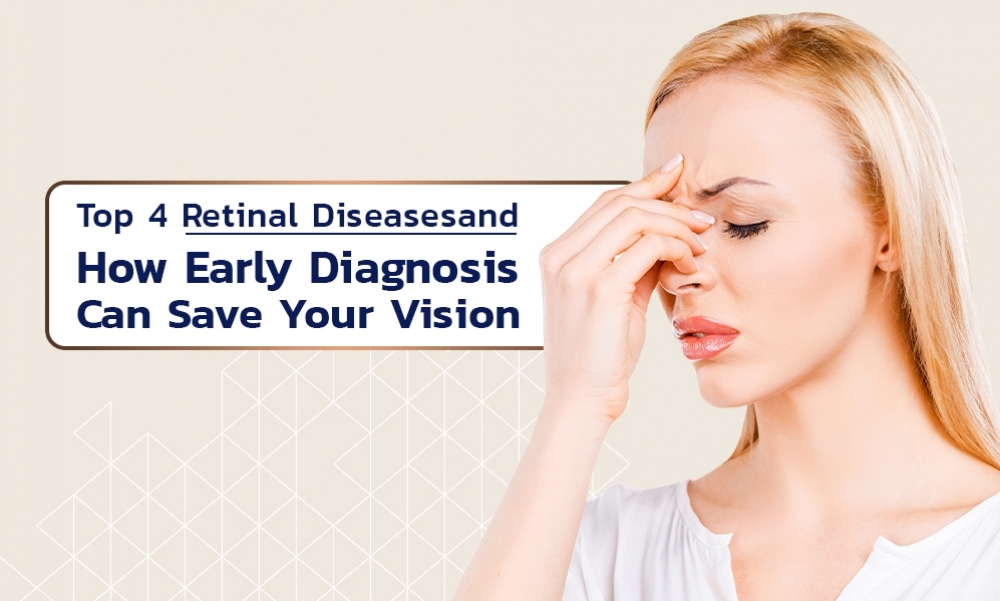Have you ever wondered how your eyes convert light into the images you see? The answer lies in your retinas. These contain light-sensitive cells that receive information and communicate it to your brain through the optic nerve – this is how you’re able to see.
Given such an indispensable function, detecting any retinal diseases early is crucial for your eye health.
If you have concerns about your retina or are seeking specialized care, Rutnin Eye Hospital offers a dedicated team of experienced retina specialists who will treat your eyes with compassion and care.
Understanding the Retina and Its Function
The function of the retina can be simplified into four steps:
Light Detection: The photoreceptor cells (rods and cones) contain light-sensitive pigments that convert incoming light into electrical signals.
Signal Processing: These initial electrical signals are then organized by layers of nerve cells within the eye.
Information Transfer: Stronger electrical messages are generated and travel along the optic nerve, a pathway connecting your eye to your brain.
Brain Interpretation: The brain's visual area receives these signals and interprets them, allowing you to perceive images.
The Importance of Early Diagnosis for Retinal Diseases
Retinal diseases that go undetected can lead to significant long-term damage. The risk is that symptoms can start very subtly, so most people don’t notice them until the problem becomes severe or has already caused considerable vision loss.
Early detection allows for proper intervention and care, giving you a fighting chance at combating the disease.
Top 4 Retinal Diseases
There is no such thing as being overly cautious with your vision. Being aware of the most common retinal diseases is a good way to stay informed about your eye health. Routine eye examinations are essential—even when no symptoms are present—as many retinal conditions develop silently over time. Early detection allows for timely treatment, helping to preserve vision and prevent irreversible damage. Lifestyle changes such as controlling blood sugar, maintaining normal blood pressure, and avoiding smoking can also significantly reduce the risk of retinal disease.
- Diabetic Retinopathy
This is a serious eye condition arising from diabetes, where prolonged high blood sugar damages the delicate blood vessels in the retina. This damage can lead to weakened and leaking vessels, blockages disrupting blood flow, and the growth of abnormal, fragile new vessels.
Symptoms include retinal swelling, bleeding within the eye, and, ultimately, significant vision impairment or blindness if not detected and managed. Often, the early stages present with no noticeable symptoms.
- Age-Related Macular Degeneration (AMD)
This affects the central part of the retina, the macula, which controls sharp, detailed vision. It often occurs in older adults due to the gradual breakdown of cells in the macula over time.
Blurry or fuzzy central vision, straight lines appearing wavy or distorted, difficulty recognizing faces, or even a dark or blurry spot in the center of vision—these are all symptoms of Age-Related Macular Degeneration. Early detection of this retinal disease can help reduce and slow down the progression of vision loss.
- Retinal Detachment
A detached retina occurs when your retina tears away from its position at the back of your eye, separating it from the underlying layer of blood vessels.
This can manifest as a sudden increase in floaters, flashes of light, blurred vision, a shadow appearing in peripheral vision, or even decreased side vision. Failure to detect or treat this disease can lead to severe and irreversible damage to vision.
- Macular Hole
A macular hole is a small break or gap that develops in the macula, blurring the central vision. Your eye contains a gel that sits in front of the macula, the part responsible for your detailed central vision. As you age, this gel naturally shrinks and separates from the retina. However, sometimes, it can get stuck. When this happens, the tugging can stretch the macula, eventually leading to a hole.
Macular holes can cause blurry or wavy central vision and trouble with close-up tasks. A central dark spot may also appear. Since there's no pain, people might wait to seek help until vision problems become severe.
How Retina Specialists Diagnose and Treat Retinal Diseases
Facing a potential retinal disease can be concerning. Fortunately, retina specialists can provide a sense of hope and direction. Their specialized training allows them to utilize a range of techniques, including:
Comprehensive Eye Exam with Advanced Imaging
This is the backbone of diagnosis. It includes a thorough dilated eye exam to directly visualize the retina.
Laser Surgery
Lasers can be used to seal retinal tears or holes, shrink abnormal blood vessels, and treat macular edema by targeting leaking blood vessels.
Intravitreal Injections
In this treatment, medications are injected directly into the vitreous gel inside the eye to target specific problems: abnormal blood vessel growth, inflammation, or fluid leakage.
Preventing Retinal Diseases with Regular Eye Care
Retinal diseases are serious and can cause detrimental, life-long vision loss and drastically impact your quality of life.
While it may be tempting to reschedule your eye exams until you notice a significant change in your vision, doing so can cause a critical delay in diagnosis and treatment.
At Rutnin Eye Hospital, we are equipped with specialized retina ophthalmologists who have the knowledge and expertise to help you maintain healthy eyes to prevent retinal issues and accurately diagnose and treat any retinal conditions that may develop.
Schedule an appointment at Rutnin Eye Hospital today and give your eyes the attention they deserve. 02-056-3333
02-056-3333





